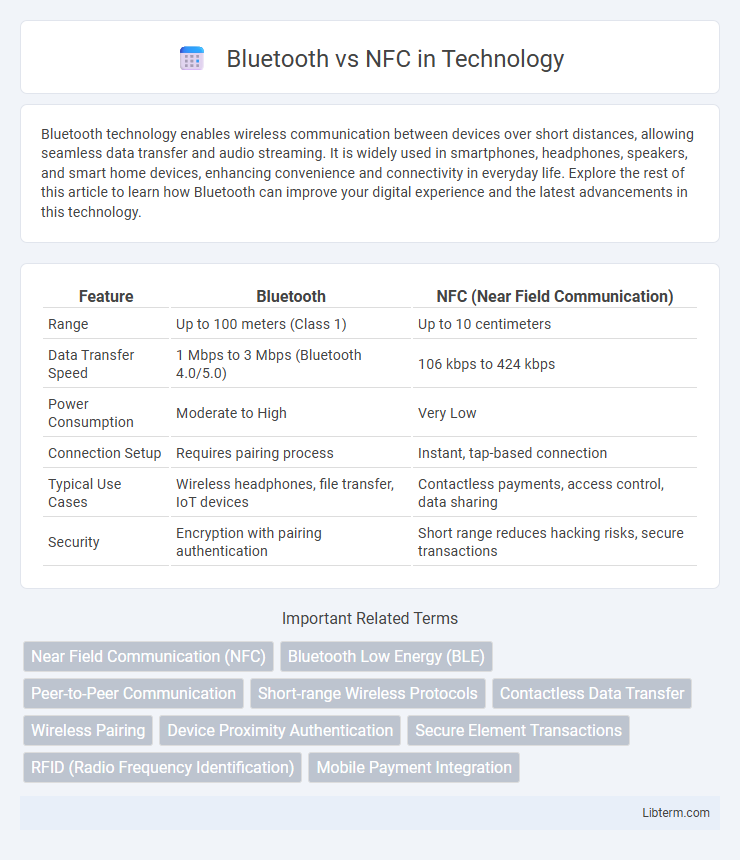Bluetooth technology enables wireless communication between devices over short distances, allowing seamless data transfer and audio streaming. It is widely used in smartphones, headphones, speakers, and smart home devices, enhancing convenience and connectivity in everyday life. Explore the rest of this article to learn how Bluetooth can improve your digital experience and the latest advancements in this technology.
Table of Comparison
| Feature | Bluetooth | NFC (Near Field Communication) |
|---|---|---|
| Range | Up to 100 meters (Class 1) | Up to 10 centimeters |
| Data Transfer Speed | 1 Mbps to 3 Mbps (Bluetooth 4.0/5.0) | 106 kbps to 424 kbps |
| Power Consumption | Moderate to High | Very Low |
| Connection Setup | Requires pairing process | Instant, tap-based connection |
| Typical Use Cases | Wireless headphones, file transfer, IoT devices | Contactless payments, access control, data sharing |
| Security | Encryption with pairing authentication | Short range reduces hacking risks, secure transactions |
Introduction to Bluetooth and NFC
Bluetooth and NFC are wireless communication technologies designed for short-range data exchange, with Bluetooth operating over distances up to 100 meters and NFC effective within 10 centimeters. Bluetooth supports higher data transfer rates, making it suitable for streaming audio and large file sharing, while NFC excels in quick, secure connections used in contactless payments and access control. Both technologies play crucial roles in modern devices, enhancing connectivity and convenience across various applications.
How Bluetooth Works
Bluetooth operates by transmitting data over short distances using radio waves within the 2.4 GHz ISM band, allowing devices like smartphones, headphones, and laptops to connect wirelessly. It establishes a secure connection by pairing devices through unique MAC addresses and uses frequency hopping spread spectrum (FHSS) technology to reduce interference and enhance transmission reliability. Bluetooth enables continuous two-way communication with low power consumption, making it ideal for audio streaming, file transfers, and peripheral device synchronization.
How NFC Works
NFC (Near Field Communication) operates through electromagnetic radio fields at a frequency of 13.56 MHz, enabling data exchange within a short range of about 4 centimeters. It uses inductive coupling between two loop antennas, where one device generates a magnetic field that powers the other device's chip to initiate communication. NFC technology supports three modes: peer-to-peer for data exchange, reader/writer for interacting with tags, and card emulation allowing devices to act as contactless cards.
Key Differences Between Bluetooth and NFC
Bluetooth offers longer-range wireless communication up to 100 meters, while NFC operates within a very short range of about 4 cm for secure, close-proximity interactions. Bluetooth supports higher data transfer rates, typically up to 3 Mbps with Bluetooth 2.0+EDR and much more with newer versions, whereas NFC transfers data much slower at around 424 Kbps. Power consumption is lower for NFC, making it ideal for simple, quick transactions like contactless payments, whereas Bluetooth is suitable for continuous data exchange and streaming applications.
Speed and Range Comparison
Bluetooth offers faster data transfer speeds, typically up to 2 Mbps with Bluetooth 4.0 and even higher with newer versions, whereas NFC speeds max out around 424 kbps. Bluetooth operates over a longer range, generally up to 100 meters depending on the device class, while NFC functions at an extremely short range of about 4 centimeters. This speed and range difference makes Bluetooth suitable for tasks like wireless audio streaming and file transfer, while NFC is ideal for quick, close-proximity exchanges such as contactless payments.
Security Features: Bluetooth vs NFC
Bluetooth incorporates robust security features such as AES-128 encryption, device authentication, and frequency hopping to mitigate eavesdropping and unauthorized access risks. NFC offers secure communication within a very short range (typically 4 cm), which inherently limits potential interception, and supports encryption protocols like SSL/TLS for contactless payment systems. Both technologies implement measures to protect data integrity, but NFC's proximity requirement generally provides stronger protection against remote attacks.
Common Applications of Bluetooth
Bluetooth is widely used for wireless audio streaming in headphones, speakers, and car infotainment systems, offering stable connections and low latency. It enables file sharing and device pairing for smartphones, laptops, and wearable devices, supporting various data transfer protocols. Bluetooth technology also powers smart home devices, fitness trackers, and IoT gadgets, providing extensive connectivity and interoperability across diverse platforms.
Common Applications of NFC
NFC technology is widely used for contactless payments, access control, and data exchange between smartphones and smart devices. Its short-range communication enables secure transactions, such as mobile wallets and public transportation ticketing systems. NFC also facilitates device pairing and information sharing in tags, making it ideal for quick interactions without manual input.
Pros and Cons of Bluetooth and NFC
Bluetooth offers a longer range up to 100 meters and supports high data transfer rates, making it ideal for wireless headphones and file sharing, but it consumes more power and can suffer from interference in crowded environments. NFC provides secure, low-energy communication within a few centimeters, perfect for contactless payments and device pairing, yet its short range limits use cases and slower data transfer restricts large file exchange. Both technologies complement each other by balancing range, speed, power consumption, and security depending on the specific application requirements.
Choosing the Right Technology for Your Needs
Bluetooth offers longer range connectivity up to 100 meters and supports high data transfer speeds, making it ideal for transferring large files and streaming audio. NFC provides ultra-short range communication within a few centimeters, enabling quick, secure interactions like contactless payments and device pairing. Selecting between Bluetooth and NFC depends on your specific use case: prioritize Bluetooth for continuous wireless connections and NFC for instant, close-proximity transactions.
Bluetooth Infographic

 libterm.com
libterm.com